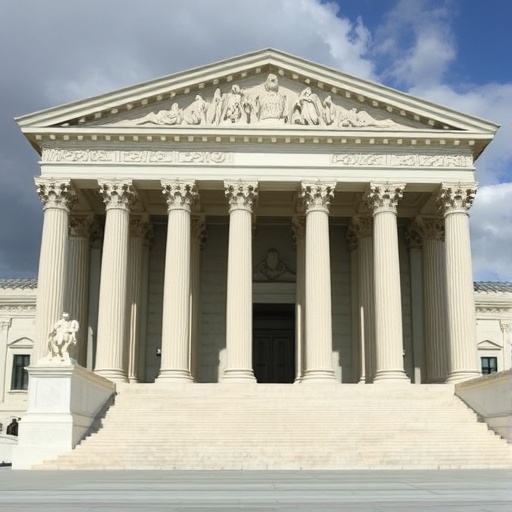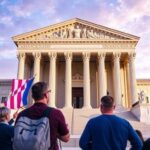Supreme Court Gears Up for Pivotal Rulings on Transgender Inclusion in Sports
In a move that could redefine equality in athletics, the U.S. Supreme Court has agreed to hear arguments in a landmark case challenging state bans on transgender athletes competing in school sports. This decision, announced last week, thrusts the issue of transgender rights into the national spotlight, potentially affecting millions of young athletes across the country. At the heart of the case is whether laws in states like Idaho and West Virginia, which prohibit transgender girls from participating in female sports teams, violate Title IX of the Education Amendments of 1972 or the Equal Protection Clause of the 14th Amendment.
- Supreme Court Gears Up for Pivotal Rulings on Transgender Inclusion in Sports
- Renewed Scrutiny on the Voting Rights Act’s Safeguards Against Discrimination
- Intersecting Battles: How Transgender Rights and Voting Protections Converge in Civil Rights Arena
- Stakeholder Perspectives: From Athletes to Election Officials on the Line
- Looking Ahead: Ramifications for Elections and Sports Policies Nationwide
The case, B.P.J. v. West Virginia State Board of Education, stems from a 12-year-old transgender girl in West Virginia who was barred from her middle school track team. Her lawsuit argues that such bans discriminate based on gender identity, a protected civil rights category. According to the ACLU, which represents the plaintiff, these restrictions affect an estimated 300,000 transgender youth in the U.S., many of whom face heightened risks of mental health issues when excluded from sports. “Sports are a vital part of childhood development, and denying transgender kids the chance to participate is a direct assault on their civil rights,” said Chase Strangio, ACLU deputy director for transgender rights.
Opponents, including conservative groups like the Alliance Defending Freedom, contend that allowing transgender athletes—who may have undergone hormone therapy or not—creates unfair advantages in women’s sports, undermining opportunities for cisgender female athletes. They cite studies from the Journal of Medical Ethics showing physiological differences post-puberty, even with treatments. “Protecting women’s sports is about fairness, not discrimination,” argued ADF senior counsel Jeremy Tedesco in a recent statement. This tension highlights the broader debate on transgender athletes’ inclusion, with 24 states now enforcing similar bans, up from just four in 2020.
The Supreme Court‘s involvement signals a potential shift, especially after its 2020 ruling in Bostock v. Clayton County extended workplace protections to transgender individuals under Title VII. Legal experts predict the court could clarify how far these protections extend to educational settings, influencing policies in public schools and universities nationwide.
Renewed Scrutiny on the Voting Rights Act’s Safeguards Against Discrimination
Simultaneously, the Supreme Court is preparing to examine a critical challenge to the Voting Rights Act (VRA) of 1965, focusing on Section 2, which prohibits voting practices that dilute minority votes. The case, Merrill v. Milligan, originated in Alabama, where plaintiffs allege that the state’s congressional redistricting map packs Black voters into a single district, diluting their influence in others despite Black residents comprising 27% of the population. This could have profound implications for elections, as a weakened VRA might embolden states to draw maps favoring one party, often at the expense of civil rights.
Enacted during the Civil Rights Movement to combat Jim Crow-era disenfranchisement, the VRA has been a cornerstone of democratic fairness. However, the Supreme Court’s 2013 decision in Shelby County v. Holder gutted Section 4’s preclearance formula, leading to a surge in restrictive voting laws. Since then, over 500 bills targeting voter access have been introduced in state legislatures, according to the Brennan Center for Justice. In Alabama’s case, federal courts initially ruled the map unconstitutional under Section 2, but the state appealed, arguing that race-neutral alternatives suffice.
“The Voting Rights Act is under siege, and this case could determine if minority voices continue to be protected in our elections,” warned Nancy Northup, president of the Center for Reproductive Rights, in an op-ed for The New York Times. Statistics underscore the stakes: In 2020, Black voters turned out at 62.6%, per the U.S. Census Bureau, helping shape battleground states, yet gerrymandering persists. Critics like the NAACP Legal Defense Fund point to data showing that without robust VRA enforcement, turnout among people of color drops by up to 10% in affected districts.
The court’s conservative majority, including Justices appointed by former President Trump, raises concerns among civil rights advocates. A ruling narrowing Section 2 could invalidate similar challenges in states like Georgia and Louisiana, where redistricting battles rage. Conversely, upholding the lower court’s decision might reinforce the VRA’s role in ensuring equitable elections.
Intersecting Battles: How Transgender Rights and Voting Protections Converge in Civil Rights Arena
These cases, though distinct, underscore a larger struggle over civil rights in America, where the Supreme Court serves as the ultimate arbiter. Transgender athletes’ quest for inclusion mirrors the VRA’s fight against voter suppression—both involve marginalized groups seeking equal access to foundational societal pillars: education/sports and democracy. The timing is no coincidence; with midterm elections looming in 2026 and the 2024 presidential race’s echoes still fresh, these rulings could mobilize voters on both sides.
Consider the demographics: Transgender individuals, numbering about 1.6 million adults per a 2022 Williams Institute study, overlap with voting rights issues, as many face barriers like ID requirements that disproportionately affect gender-nonconforming people. In sports, exclusion from teams can deter civic engagement, with research from GLSEN showing transgender youth experiencing 40% higher absenteeism when facing discrimination. Meanwhile, VRA challenges often intersect with LGBTQ+ rights, as seen in Florida’s recent laws targeting both drag shows and voting access.
Legal scholars like Erwin Chemerinsky, dean of UC Berkeley School of Law, note the ideological stakes. “The court is at a crossroads, balancing individual rights against state interests in an era of polarization,” Chemerinsky told Reuters. Public opinion polls from Pew Research Center reveal a divide: 60% of Americans support transgender nondiscrimination laws, but only 38% favor trans athletes in sports matching their gender identity. On voting, 79% back the VRA’s continuation, yet partisan lines blur support for enforcement.
Advocacy groups are ramping up efforts. The Human Rights Campaign has launched a $5 million ad campaign highlighting personal stories of transgender athletes, while the Leadership Conference on Civil and Human Rights is rallying for VRA preservation through amicus briefs from over 100 organizations. These intersections amplify the cases’ shareability on social media, where #TransRightsAreHumanRights trends alongside #ProtectTheVote.
Stakeholder Perspectives: From Athletes to Election Officials on the Line
Voices from the front lines paint a vivid picture of the human impact. For transgender athletes, take Lia Thomas, the University of Pennsylvania swimmer who became a flashpoint in 2022 by winning an NCAA title. Though not directly involved, her story fuels the debate: “I just wanted to swim like everyone else,” Thomas shared in a CNN interview, emphasizing mental health tolls. Parents of cisgender athletes counter with concerns over scholarships; a 2023 NCAA report found women’s sports funding at $200 million annually, with equity fights ongoing.
In the voting realm, Alabama’s Black voters like Marquis Evans, a plaintiff in the case, describe frustration. “My community votes, but our power is diluted—it’s like shouting in a soundproof room,” Evans told AP. Election officials, such as Georgia Secretary of State Brad Raffensperger, warn of chaos: “Weakening the VRA invites more lawsuits, delaying fair elections,” he stated during a 2023 conference. Nationally, the U.S. Election Assistance Commission reports a 15% rise in voting disputes since Shelby, straining resources.
Civil rights leaders draw parallels. Rev. Al Sharpton, founder of the National Action Network, linked the issues in a speech: “Whether it’s a trans kid on the field or a Black voter at the polls, it’s about denying dignity. The Supreme Court must stand for justice.” Conservative voices, like Sen. Tom Cotton (R-AR), argue overreach: “States should decide sports and maps, not federal judges imposing woke agendas.” These clashing views fuel media coverage, with outlets like Fox News and MSNBC dedicating segments to expert panels.
Broader data adds depth: A 2023 Gallup poll shows 70% of Democrats view these as core civil rights issues, versus 25% of Republicans. Economically, sports exclusion costs transgender youth $1.2 billion in potential scholarships annually, per an Urban Institute estimate, while VRA lapses correlate with $500 million in litigation costs since 2013.
Looking Ahead: Ramifications for Elections and Sports Policies Nationwide
As oral arguments approach in early 2025, the Supreme Court’s decisions could reshape landscapes for years. A pro-inclusion ruling on transgender athletes might invalidate bans in half the states, prompting new federal guidelines from the Department of Education and boosting participation rates. Conversely, upholding restrictions could spur more state-level fights, deepening divides in school boards and youth leagues.
For the Voting Rights Act, a narrow interpretation of Section 2 might greenlight gerrymandered maps in 10+ states, per Princeton Gerrymandering Project projections, tilting elections toward Republicans in House races. Strengthening it could empower challenges in swing states like Arizona and Wisconsin, enhancing turnout among 40 million minority voters. Civil rights groups anticipate a flood of litigation either way, with the NAACP planning a national voter mobilization drive.
Politically, these cases energize bases: Progressives see victories as bulwarks against regression, while conservatives frame them as defenses of tradition. With 2026 midterms on the horizon, outcomes could influence turnout—historically, landmark rulings boost participation by 5-7%, according to MIT election studies. Internationally, eyes from the EU and UN watch, as U.S. civil rights precedents inspire global movements.
Ultimately, the Supreme Court stands poised to affirm or erode pillars of equality, reminding us that elections and sports are battlegrounds for America’s soul. Stakeholders urge public engagement: Submit amicus briefs, contact legislators, or vote in local races to shape the narrative. As Justice Sonia Sotomayor often emphasizes, “Democracy thrives on inclusion.” The coming months will test that principle profoundly.









